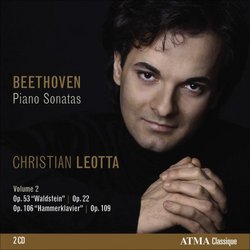| All Artists: Ludwig van Beethoven, Christian Leotta Title: Beethoven: Piano Sonatas Members Wishing: 0 Total Copies: 0 Label: Atma Classique Original Release Date: 1/1/2009 Re-Release Date: 4/28/2009 Genre: Classical Styles: Chamber Music, Forms & Genres, Sonatas, Historical Periods, Classical (c.1770-1830) Number of Discs: 1 SwapaCD Credits: 1 UPC: 722056248723 |
Search - Ludwig van Beethoven, Christian Leotta :: Beethoven: Piano Sonatas
CD Details |
CD ReviewsVolume II of best new recording of Beethoven's 32 Piano Sona John Lambert | 06/26/2009 (5 out of 5 stars) "I'm posting the following review by Phil Muse on the Audio Video Club of Atlanta, which I consider as a profound and competent analysis on Christian Leotta's interpretation of Beethoven's music.
John Lambert, New York City, USA "Italian pianist Christian Leotta builds on his earlier release in an ongoing cycle with an even more impressive entry of Beethoven Piano Sonatas: Vol. 2. The 2-CD slimline consists of Sonatas No. 11 in B-flat, Op. 22; No. 21 in C, Op. 53, "Waldstein"; No. 29 in B-flat, Op. 106, "Hammerklavier" and No. 30 in E, Op. 109. In terms of texture, rhythm, and keyboard effects that are often nothing short of sensational, it's a formidable lineup. Leotta's skills are more than equal to the task. His tone is beautifully centered, his timing impeccable. His feeling for the rhythm and the degree of energy to invest in any particular passage is flawless, and his dynamic prowess includes a true pianissimo in a variety of discrete shadings. Most significantly, he constantly thinks his way through Beethoven's music, balancing the intellectual end emotive elements so perfectly that we have the exciting awareness of intimately knowing the heart and mind of this composer. Sonata No. 11 comes across here as Beethoven at his most carefree. The flowing arpeggios in the opening Allegro con brio set the tone for a work that will end in a brilliant Rondo with cross-rhythms and syncopations. In Leotta's hands, it seems as if it could go on forever and we wouldn't mind. There's even a quasi-fugal passage that foreshadows what the composer will do in the "Hammerklavier." Sonata No. 30 is another "happy" sonata, but with a difference. Its opening, marked Vivace ma non troppo, seems to flow carelessly and easily, like a free improvisation, until it arrives at a sudden cadence, as if the heady dreams of youth were confronted by the sobering thought, "Is that all there is?" A brief, impassioned scherzo marked Prestissimo is succeeded, unusually, by a slow finale, marked Andante and twice as long as both its predecessors combined. It's in the form of a theme with six variations, which Leotta characterizes beautifully in terms of Beethoven's unusually detailed expressive markings. In the "Waldstein" Sonata, Leotta takes the Allegro con brio opening movement with all the vivacity and high-profile rhythm that it requires, but not with the excessive velocity with which some pianists have endowed it. This, after all, is not the climax of the work. He does a great job with the development section, which is built of the most diverse materials that include some quasi-fugal stuff before the brilliant coda. His remarkable sense of timing really comes into play here in this most dramatic and suspenseful of Beethoven movements. The Adagio is not a true slow movement, but the introduction to a Rondo finale that builds in builds in complexity and excitement as it releases the harmonic tensions created by the opening movement. These are pyrotechnics with a purpose, and Leotta conveys it to us in all his explosive vitality. Leotta's superb sense of pacing and grasp of fine distinctions in musical time receive their ultimate test in Sonata 29, the "Hammerklavier." So does his command of the finely shaded distinctions of pianissimo phrasing that we hear at both ends of the remarkable slow movement, Adagio sostenuto, which is further marked appassionato e con molto sentimento, requiring the utmost in the pianist's expressive range. At 19:42 this movement is unhurried without losing any of the vital tension that holds it together. Here, as in the opening movement, Leotta shows a masterful grasp of Beethoven's use of trills and variations in tempi to generate excitement and lead us forward into new and ever more interesting vistas of the imagination. His mastery is undiminished in that massive whirlwind of a double fugue that concludes the work in the most decisive manner imaginable. In a two-year period when we've heard some really distinguished Beethoven performances, this new offering by Leotta may be the best yet". Phil Muse, Audio Video Club of Atlanta, May 2009" |

